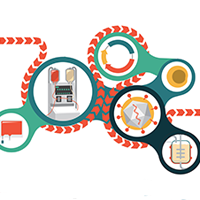Understanding the Role of Critical Quality Attributes along the Commercialization Pathway
Cell Gene Therapy Insights 2018; 4(3), 227-230.
10.18609/cgti.2018.023
What are critical quality attributes (CQA) and how does quality of source cells ultimately influence the quality of end product?
With respect to source cells, the answer depends on whether the product is autologous or allogeneic. The ability to really control the quality of source material is difficult, especially for an autologous product. Some areas of control for an autologous product are defining apheresis collection procedures and parameters with specified limits, such as collection volume, and what kind of anticoagulant you might need, for example.
In the autologous world, you are beholden to the quality of the patient cells. For autologous therapies, investing in infectious disease testing may not be as critical, because the cells are going back into the same patient. By contrast, in the allogeneic world, you definitely can drive more homogeneity and quality attributes to your starting material than you can for autologous products. For allogeneic therapies, full infectious disease screening and verification of donor screening are required. You may be able to ensure starting material has a greater concentration of a specific cell population or a specific volume can be selected. So, you actually can control some of your attributes more for an allogeneic process, than you can for an autologous process. But certainly, the attributes you require for allogeneic will be driven by your manufacturing process, and what parameters you require to be successful in your process.
In recent years, there has been an increased emphasis on the importance of CQAs. From your perspective, has this advanced our understanding of what CQAs are needed for various therapy types?
I started off my career in biotech working with monoclonal antibodies. In contrast to cell and gene therapies, where the processes, CQAs and the final release testing are all really well defined and understood, when you move into the world of cell and gene therapy, I think that CQAs are less consistent, less rote. It’s something that each company and each process needs to define based on their process and product understanding.
CQAs are incredibly important in the world of cell and gene therapy processing, particularly because the starting material inherently is quite variable, especially for autologous therapies. In addition, processes must be aseptic, but often times they are open and manual manipulations. Unlike protein manufacturing, cell and gene therapies are unable to undergo some of the bio-burden and endo-toxin removal steps. For example, you can’t do a low pH inactivation to kill virus as they may be present in living cells and you can’t do all types of filtration on cell therapies.
For cell and gene therapies, you really need to have a strong understanding of your manufacturing process. It’s critical to know what your CQAs should be throughout your manufacturing process, because you don’t have some of those fail safes you might have in other types of pharmaceutical or biotechnology manufacturing.
Let’s say your source cells meet initial CQAs, what factors of your manufacturing process can impact the CQAs?
From a product success attribute the environment is critical. As I mentioned, there’s a lot of manual manipulation, open steps, and aseptic processing without any sort of terminal sterilization. So, it’s critical that your environment is appropriately cleaned and monitored. In addition, it’s important that your equipment is appropriately cleaned, maintained and calibrated. These are not necessarily CQAs for a product, but they certainly contribute to the success of your product.
What are some common mistakes that you’ve seen companies make in terms of ensuring the CQA of source cells? Do you have and advice as how to avoid these issues?
There are definitely common mistakes that young companies make in general and they’re not necessarily isolated to cell and gene therapy manufacturing. Firstly, it’s not uncommon that the processes are born out of an academic institution, where they don’t have strong GMP experience at later phase clinical or commercial environments. So, the things that might be important in later phase and commercial development, just don’t have the same level of importance for academia. An example would be level of grade or quality of raw materials. Certainly, in an academic environment you can and should explore processes with a lower grade of material to manage costs. However, those lower grade materials are no longer acceptable when you move forward to later phase and commercial processes. That can be a big hurdle to change out raw materials as you are moving quickly through the commercialization process. Secondly, not having well-developed and qualified analytics is another common mistake that is made. Early stage companies are typically moving really quickly and need to fully characterize their process. And if the analytics are not at an appropriate state and not reproducible, that can be a big hurdle to moving towards commercialization. In a general sense, the most common mistake is moving really quickly and not building stronger GMPs earlier on in the process. Not doing this early can make it really hard and expensive to do later on.
From your perspective, what are some of the unmet needs that remain for CQAs?
One of the pain points is lack of consistency. For example, with cell and gene therapies, we rely strongly on cell counting to understand the viability of our product. And there has been traditionally a lack of consistency around that. Just recently an ISO-standard was released on cell counting. Having an ISO standard coming out for something like that tells me that industry voices are being heard and that the industry is definitely attempting to drive towards consistency. It’s going to be a long road for some things. But certainly, that’s a good win for cell and gene therapy.
Do you have any final thoughts or advice that you’d like to share?
My first piece of advice would be that companies ensure they have a target product profile (TPP) sooner rather than later. The TTP should outline who your patient population is, how you plan to administer your product, and what kind of final container you want. The TPP should really help to drive your process development, towards a product that is viable and usable in the market.
Second, I would also encourage people, particularly in academia, to gain an understanding on GMP requirements for later stage products. If there’s something that they think will move forward into later stage clinical and potentially commercial development, then they can start planning and get a jump start on requirements for later stage production. A lot of times, when new therapies have some degree of success early on, people get excited and want to move forward quickly, but this can put you at a disadvantage from the beginning for properly developing your product. So, anything you can do to at least plan and understand the requirements for a later phase clinical product will get you a long way.
Affiliation
Anna Gilbert
Director, Quality Assurance, Nohla Therapeutics, Inc
This work is licensed under a Creative Commons Attribution- NonCommercial – NoDerivatives 4.0 International License.


